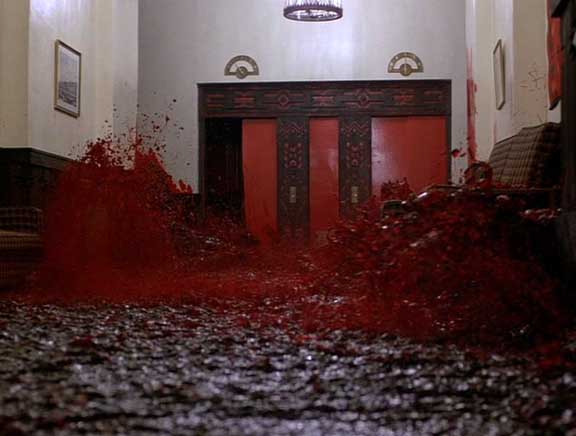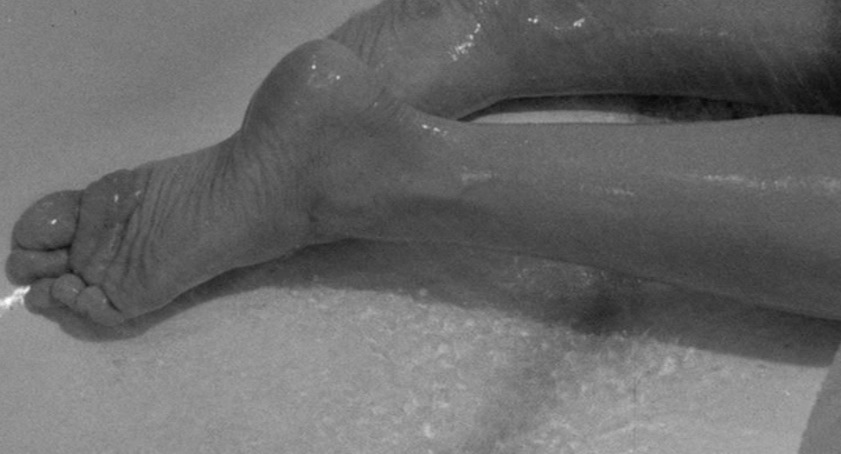The color of blood: a study in scarlet

Bright, thick, almost waxy blood: Brian DePalma's "Sisters" (1973).

Thinner, but still alarmingly bright: Quentin Tarantino's "Pulp Fiction" (1994).
"Yellow... is the color of caution." -- Opal from the BBC (Geraldine Chaplin) in Robert Altman's "Nashville"
Red is the color of alarm. Perhaps because it is the color of blood. Over the years, that color has changed, along with our taste in blood. In movies, I mean. What was once alarmingly "realistic" now looks either stylized (if it's a good movie) or fakey (if it's not so good). When Neil Sedaka and Elton John sang about "Bad Blood" in 1975, maybe that's what they really had in mind (because, after all, who knows what "Doo-ron, doo-ron, dit-dit-dit-di ron-ron" was supposed to mean? Apart from the reference to the Crystals).

Near-black: The Coens' "No Country for Old Men" (2007).
Before the late '70s, blood was generally (and, remember, these are generalizations -- there are certainly exceptions) bright red and opaque, like nail polish or latex paint. It was often compared to ketchup, which in many cases it was. Since then, our taste for blood runs darker, anywhere from ruby red to almost black. It's a bit more transparent than it used to be, and appears somewhat shinier and stickier -- perhaps because, as we now know, the effects folks have supposedly hit upon the magic formula for photogenic blood made from Karo corn syrup (in some cases the high fructose variety, the same ingredient used in... almost everything that doesn't use a low-cal sweetener). The shade changes with the lighting, the thickness (a smear or a puddle?), and the surface on which it is splashed. The blood splashed on Samuel L. Jackson's Jheri Curled hair naturally appears darker than the blood all over the upholstery of the back seat, or the blood splooshed on the back window as daylight streams through it.
(Red Alert: Possible bloody spoiler text and images ahead for "Heroes" [Season One], "There Will Be Blood," "Deep Red," "The Conversation"...)

... and this is blue: Jean-Luc Godard's "Pierrot le Fou" (1966).
"It's not blood, it's red." -- Jean-Luc Godard on the use of color in "Pierrot le fou" (1965)
Red is not a color to be treated carelessly. It has a visceral impact when we see it -- not just in the form of blood, but in stop signs, fire trucks, police lights, stoplights and stop signs. The "finger on the button" button is assumed to be red, as is the Cold War "hot line" from the Oval Office to the Kremlin. It helped the domestic propaganda efforts significantly that Soviet Communism was identified with red. "Commies" themselves were "reds." And, of course, there were the "Red Chinese." Red lights always indicate warning or danger -- off-limits, do not proceed -- unless they're in a "red light district," where they suggest another kind of forbidden activity.

Drowning in a sea of blood: Stanley Kubrick's "The Shining" (1980). This image made for the most powerful teaser trailer ever. Kubrick liked it so much he felt he had to incorporate it into the movie.
In Nicolas Roeg's "Don't Look Now" (the scariest movie I've ever seen, and I love horror movies), the very sight of red sends a chill down your spine. It begins innocently enough with a little girl in a red mack, but immediately the scene takes on an atmosphere of dread. A spreading smear of red on a slide. A glimpse of a figure in red in the dark alleys of Venice. A pool of blood spreading and spreading as if to engulf the screen. (See "The Conversation" and, of course, "The Shining.") Likewise in Kubrick's Outlook Hotel, where a red(rum) bathroom or a red jacket worn by a tiny figure in a maze sets off alarms in your head.
* * *

Rusty, muddy, R-rated: Martin Scorsese's "Taxi Driver" (1976).
My favorite movie-blood story belongs to Martin Scorsese. The way he tells it, the MPAA freaked when they saw the bloodbath in "Taxi Driver" (1976) and was ready to slap it with an X rating for violence. They suggested he tone it down -- as in, tone down the red -- in order to get an R. So, Scorsese put the scene through some kind of chem wash or something that made the blood more brownish. In his view, it made the scene more sickening and disturbing, but he got his R rating.

It would have been pink: Alfred Hitchock's "Psycho" (1960).

One of the most effective and horrifying uses of blood-red ever, in a pristine white bathroom: Francis Ford Coppola's "The Conversation" (1974).
Alfred Hitchcock said he knew he had to shoot "Psycho" (1960) in black and white because in color the blood going down the drain in the shower scene would be pink. And pink is not all that scary.

"Heroes" (2007). Molasses from heaven? Or hell?

"Heroes" (2007): Dark enough to be an oil spill.

"Heroes" (2007): Where the bad guy sat, with ketchup bottle prominently featured.
I have been catching up with the first season of "Heroes" recently (and, by the way, it's far and away the best comicbook/superhero adaptation I've seen since "Superman" in 1978 -- but more about that later). There's a shot of blood dripping down a woman's face that made me wonder if it was supposed to be molasses or chocolate sauce or something dripping from a shelf above her. Ironically, and quite wittily in keeping with the cleverness of the show in general, she's standing next to two bottles of red syrup, opening a large can of what looks like stewed tomatoes (with a bright red label) when it occurs. She falls out of the frame and spots of red appear out of focus behind her. The next shot features a plastic squeeze bottle of ketchup in the lower right corner, followed by a shot of a woman in a bright red apron. (This episode, "Seven Minutes to Midnight," was directed by Paul Edwards, who has also done installments of "Lost," "Pushing Daisies" and "Battlestar Gallactica." I'm going to be looking for his name from now on.)

A cleaver creates quite a splash... of not-so-terribly-deep red nail polish: Dario Argento's "Deep Red" (1975):

It is customary for the dead and injured to drool red. Note the waxy build-up. "Deep Red."

Modern dark blood, as in "There Will Be ____" (detail). Image cropped to protect the guilty. Nobody's innocent.
Some movies avoid red altogether, while others weave it into the design of the film. So, what blood (or red) images have most strongly affected you and why? Which have struck you as the most surreal ("The Shining"), disturbing ("Don't Look Now"), funny ("Monty Python and the Holy Grail") or phony (???)?
P.S. Be sure to read Girish Shambu's perceptive piece in Artforum on the new Criterion DVD release of Paul Schrader's "Mishima: A Life in Four Chapters," which includes this pertinent paragraph:
Included in the DVD set is the only film Mishima ever directed, the half-hour-long "Patriotism" (1966), and it’s a shocker. In it, a naval officer and his wife make love and then commit seppuku for the sake of the emperor. The film features no dialogue and narrates its story through calligraphic writing in the credit sequence. The sets are Noh-like, severe and minimalist, with blazing white walls. When the unrelenting whiteness of the images is finally relieved, it is with violent sprays and splashes of black, the color of blood in this black-and-white film.





